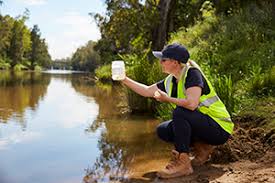
Tackling PFAS: A Natural Approach to a Modern Environmental Threat
Per- and polyfluoroalkyl substances (PFAS) have become one of the most pressing environmental concerns in recent years. Fortunately, conventional solutions such as coal-derived granular activated carbon (GAC), ion exchange (IX), and advanced technologies like foam fractionation and high-rejection reverse osmosis have proven effective at reducing PFAS levels in water.
But there’s a surprising development in the field: some of the most promising PFAS treatment methods involve natural materials—like corn, coconut, and clay.
Why PFAS Are So Difficult to Remove
To appreciate these newer approaches, it's crucial to understand why PFAS are so challenging. These human-made chemicals have been widely used since the 1940s in products like non-stick cookware, waterproof clothing, and firefighting foams. What makes them so useful—strong chemical bonds that resist water and oil—also makes them extremely persistent in the environment and difficult to break down.
Turning to Nature: Corn, Coconut, and Clay
Engineers and scientists are now leveraging natural resources to develop PFAS treatment methods that are both effective and environmentally sustainable. Here's how:
Per- and polyfluoroalkyl substances (PFAS) have become one of the most pressing environmental concerns in recent years. Fortunately, conventional solutions such as coal-derived granular activated carbon (GAC), ion exchange (IX), and advanced technologies like foam fractionation and high-rejection reverse osmosis have proven effective at reducing PFAS levels in water.
But there’s a surprising development in the field: some of the most promising PFAS treatment methods involve natural materials—like corn, coconut, and clay.
Why PFAS Are So Difficult to Remove
To appreciate these newer approaches, it's crucial to understand why PFAS are so challenging. These human-made chemicals have been widely used since the 1940s in products like non-stick cookware, waterproof clothing, and firefighting foams. What makes them so useful—strong chemical bonds that resist water and oil—also makes them extremely persistent in the environment and difficult to break down.
Turning to Nature: Corn, Coconut, and Clay
Engineers and scientists are now leveraging natural resources to develop PFAS treatment methods that are both effective and environmentally sustainable. Here's how:
- Corn-Based Solutions: Materials derived from corn, especially cyclodextrins, have shown strong potential in capturing PFAS molecules. These compounds act like molecular traps, binding PFAS compounds efficiently. Not only is this method effective, but it’s also renewable and eco-friendly.
- Activated Carbon from Coconut Shells: Coconut-based activated carbon has demonstrated good performance in PFAS filtration. Its naturally porous structure provides a large surface area, enhancing its ability to capture these stubborn compounds.
- Clay-Based Materials: Certain types of clay have the ability to retain PFAS through their layered structures. These naturally occurring materials are being refined to enhance their performance in PFAS removal.
How These Natural Materials Work
These treatments operate through well-understood scientific processes:
These treatments operate through well-understood scientific processes:
- Adsorption: This is the process by which PFAS molecules stick to or are trapped in the surface of a material. Activated carbon, corn-based compounds, and clays all utilize adsorption, providing numerous binding sites that capture PFAS.
- Ion Exchange: PFAS molecules often carry a negative charge. Ion exchange resins, which have positively charged sites, can attract and hold onto these molecules, allowing cleaner water to pass through. Some systems even combine natural materials with ion exchange for better performance.
Advantages of Natural PFAS Treatments
These innovative approaches offer several benefits:
These innovative approaches offer several benefits:
- Environmentally Friendly: Using renewable sources like corn and coconut supports sustainability.
- Effective: Studies show high removal rates for various types of PFAS.
- Adaptable: These materials can be used in a range of applications, from small-scale systems to large municipal operations.
Moving Forward
As PFAS regulations become stricter, these sustainable solutions provide a proactive way for communities and industries to stay ahead. Pilot projects across the country are already seeing success by blending traditional methods with natural treatment options. For those yet to act, now is the time—delays could mean more stringent rules, higher costs, and growing public concern.
Taking early steps provides:
As PFAS regulations become stricter, these sustainable solutions provide a proactive way for communities and industries to stay ahead. Pilot projects across the country are already seeing success by blending traditional methods with natural treatment options. For those yet to act, now is the time—delays could mean more stringent rules, higher costs, and growing public concern.
Taking early steps provides:
- Greater flexibility to comply with future standards
- Alignment with environmental sustainability goals
- Increased trust in water safety from the public
A Partnership Between Nature and Innovation
The ongoing battle against PFAS contamination is revealing that some of the best tools may come straight from nature. By tapping into the unique properties of corn, coconut, and clay, researchers are creating safer, more sustainable treatment methods. As our understanding deepens, these natural materials may become a cornerstone of effective PFAS management—helping ensure cleaner water and a healthier environment for generations to come.
The ongoing battle against PFAS contamination is revealing that some of the best tools may come straight from nature. By tapping into the unique properties of corn, coconut, and clay, researchers are creating safer, more sustainable treatment methods. As our understanding deepens, these natural materials may become a cornerstone of effective PFAS management—helping ensure cleaner water and a healthier environment for generations to come.


 Natural Solutions for PFAS Removal: Corn, Coconut & Clay
Natural Solutions for PFAS Removal: Corn, Coconut & Clay




 Companies
Companies